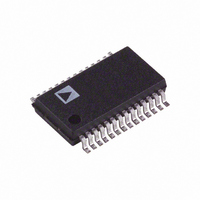AD7899ARSZ-2 Analog Devices Inc, AD7899ARSZ-2 Datasheet - Page 10

AD7899ARSZ-2
Manufacturer Part Number
AD7899ARSZ-2
Description
14-BIT BIPOLAR INPUT SINGLE SUPPLY ADC
Manufacturer
Analog Devices Inc
Datasheet
1.AD7899ARSZ-1.pdf
(16 pages)
Specifications of AD7899ARSZ-2
Number Of Bits
14
Sampling Rate (per Second)
400k
Data Interface
Parallel
Number Of Converters
1
Power Dissipation (max)
125mW
Voltage Supply Source
Single Supply
Operating Temperature
-40°C ~ 85°C
Mounting Type
Surface Mount
Package / Case
28-SSOP (0.200", 5.30mm Width)
Number Of Elements
1
Resolution
14Bit
Architecture
SAR
Sample Rate
400KSPS
Input Polarity
Unipolar
Input Type
Voltage
Rated Input Volt
2.5/5V
Differential Input
No
Power Supply Requirement
Single
Single Supply Voltage (typ)
5V
Single Supply Voltage (min)
4.75V
Single Supply Voltage (max)
5.25V
Dual Supply Voltage (typ)
Not RequiredV
Dual Supply Voltage (min)
Not RequiredV
Dual Supply Voltage (max)
Not RequiredV
Power Dissipation
125mW
Differential Linearity Error
±1LSB
Integral Nonlinearity Error
±2LSB
Operating Temp Range
-40C to 85C
Operating Temperature Classification
Industrial
Mounting
Surface Mount
Pin Count
28
Package Type
SSOP
Input Signal Type
Single-Ended
Lead Free Status / RoHS Status
Lead free / RoHS Compliant
For Use With
EVAL-AD7899CBZ - BOARD EVAL FOR AD7899
Lead Free Status / Rohs Status
Compliant
Available stocks
Company
Part Number
Manufacturer
Quantity
Price
Part Number:
AD7899ARSZ-2
Manufacturer:
ADI/亚德诺
Quantity:
20 000
AD7899
AD7899-3
Figure 4 shows the analog input section of the AD7899-3. The
analog input range is ± 2.5 V on the V
can be left unconnected but if it is connected to a potential then
that potential must be GND.
For the AD7899-3, R1 = 4 kΩ and R2 = 4 kΩ. The resistor
input stage is followed by the high input impedance stage of the
track/hold amplifier.
The designed code transitions take place midway between suc-
cessive integer LSB values (i.e., 1/2 LSB, 3/2 LSBs, 5/2 LSBs
etc.) LSB size is given by the formula, 1 LSB = FSR/16384.
Output coding is two’s complement binary with 1 LSB = FSR/
16384 = 5 V/16384 = 610.4 µV. The ideal input/output transfer
function for the AD7899-3 is shown in Table III.
Analog Input
+FSR/2 – 3/2 LSB
+FSR/2 – 5/2 LSB
+FSR/2 – 7/2 LSB
GND + 3/2 LSB
GND + 1/2 LSB
GND – 1/2 LSB
GND – 3/2 LSB
–FSR/2 + 5/2 LSB
–FSR/2 + 3/2 LSB
–FSR/2 + 1/2 LSB
NOTES
1
2
FSR is full-scale range is 5 V, with V
1 LSB = FSR/16384 = 610.4 µV (± 2.5 V – AD7899-3) with V
Table III. Ideal Input/Output Code Table for the AD7899-3
V
V
V
REF
INB
INA
6k
l
2
R2
REFERENCE
R1
2.5V
REF
= 2.5 V
Digital Output
Code Transition
011 . . . 110 to 011 . . . 111
011 . . . 101 to 011 . . . 110
011 . . . 100 to 011 . . . 101
000 . . . 001 to 000 . . . 010
000 . . . 000 to 000 . . . 001
111 . . . 111 to 000 . . . 000
111 . . . 110 to 111 . . . 111
100 . . . 010 to 100 . . . 011
100 . . . 001 to 100 . . . 010
100 . . . 000 to 100 . . . 001
TRACK/HOLD
TO ADC
REFERENCE
CIRCUITRY
INA
input. The V
AD7899-3
TO INTERNAL
COMPARATOR
REF
= 2.5 V.
INB
input
TIMING AND CONTROL
Starting a Conversion
The conversion is initiated by applying a rising edge to the
CONVST signal. This places the track/hold into hold mode and
starts the conversion. The status of the conversion is indicated
by the dual function signal BUSY/EOC. The AD7899 can operate
in two conversion modes, EOC (End Of Conversion) mode and
BUSY mode. The operating mode is determined by the state of
CONVST at the end of the conversion.
Selecting a Conversion Clock
The AD7899 has an internal laser trimmed oscillator which can
be used to control the conversion process. Alternatively an external
clock source can be used to control the conversion process. The
highest external clock frequency allowed is 6.5 MHz. This means
a conversion time of 2.46 µs compared to 2.2 µs using the inter-
nal clock. However in some instances it may be useful to use an
external clock when high throughput rates are not required. For
example two or more AD7899s may be synchronized by using
the same external clock for all devices. In this way there is no
latency between output logic signals due to differences in the
frequency of the internal clock oscillators.
On the rising edge of CONVST the AD7899 will examine the
status of the CLKIN pin. If this pin is low it will use the internal
laser trimmed oscillator as the conversion clock. If the CLKIN pin
is high the AD7899 will wait for an external clock to be supplied
to this pin which will then be used as the conversion clock. The
first falling edge of the external clock should not happen for at
least 100 ns after the rising edge of CONVST to ensure correct
operation. Figure 5 shows how the BUSY/EOC output is synchro-
nized to the CLKIN signal. Each conversion requires 16 clocks.
The result of the conversion is transferred to the output data
register on the falling edge of the 15th clock cycle. When the
internal clock is selected the status of the CLKIN pin is free to
change during conversion but the CLKIN setup and hold times
must be observed in order to ensure that the correct conversion
clock is used. The CLKIN pin can also be tied low permanently if
the internal conversion clock is to be used.
BUSY/EOC
CONVST
CLKIN
RD
CS
t
9
t
11
1 2 3 4 5 6 7 8 9 10 11 12 13 14 15 16














